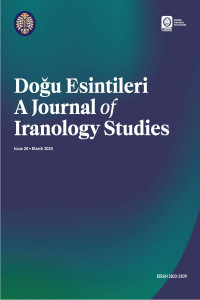Abstract
Abstract
Without exaggeration, one of the symbols that make up the culture of nations is literature and music (local songs) which are rooted in the customs of a nation. Folk music or local/regional music is a form of traditional music that is passed down from generation to generation. The chogur instrument is less known in the music of regions of iran, which is sometimes confused with this instrument due to its similarity with the Qupoz of Azerbaijan. An instrument from the tanbur family, which became popular among authentic Iranian musicians about 100 years ago, and was first made by Armenian artists from the Chenaghchi village of Saveh city. This instrument is one of the instruments of the Turkic regions of the central region of Iran, which is mostly played among the Turkic tribes of the central province.
Despite the differences and similarities it has with Azerbaijan's qupoz instrument, chogur is called Ashiqi instrument. In this article, Aashiq and Aashiqi's narration are discussed, the poems and Aashiq of the region are discussed, and for a better understanding of this issue, after the introduction of the Chegur instrument, its differences with the Qupuz instrument are also examined.
Key words: Chogur, Ashiq, Ashiqi music
Keywords
Abstract
Abstract
Without exaggeration, one of the symbols that make up the culture of nations is literature and music (local songs) which are rooted in the customs of a nation. Folk music or local/regional music is a form of traditional music that is passed down from generation to generation. The chogur instrument is less known in the music of regions of iran, which is sometimes confused with this instrument due to its similarity with the Qupoz of Azerbaijan. An instrument from the tanbur family, which became popular among authentic Iranian musicians about 100 years ago, and was first made by Armenian artists from the Chenaghchi village of Saveh city. This instrument is one of the instruments of the Turkic regions of the central region of Iran, which is mostly played among the Turkic tribes of the central province.
Despite the differences and similarities it has with Azerbaijan's qupoz instrument, chogur is called Ashiqi instrument. In this article, Aashiq and Aashiqi's narration are discussed, the poems and Aashiq of the region are discussed, and for a better understanding of this issue, after the introduction of the Chegur instrument, its differences with the Qupuz instrument are also examined.
Key words: Chogur, Ashiq, Ashiqi music
Keywords
Abstract
Abstract
Without exaggeration, one of the symbols that make up the culture of nations is literature and music (local songs) which are rooted in the customs of a nation. Folk music or local/regional music is a form of traditional music that is passed down from generation to generation. The chogur instrument is less known in the music of regions of iran, which is sometimes confused with this instrument due to its similarity with the Qupoz of Azerbaijan. An instrument from the tanbur family, which became popular among authentic Iranian musicians about 100 years ago, and was first made by Armenian artists from the Chenaghchi village of Saveh city. This instrument is one of the instruments of the Turkic regions of the central region of Iran, which is mostly played among the Turkic tribes of the central province.
Despite the differences and similarities it has with Azerbaijan's qupoz instrument, chogur is called Ashiqi instrument. In this article, Aashiq and Aashiqi's narration are discussed, the poems and Aashiq of the region are discussed, and for a better understanding of this issue, after the introduction of the Chegur instrument, its differences with the Qupuz instrument are also examined.
Key words: Chogur, Ashiq, Ashiqi music
Keywords
Details
| Primary Language | Persian |
|---|---|
| Subjects | Persian Language, Literature and Culture |
| Journal Section | Article |
| Authors | |
| Publication Date | March 26, 2024 |
| Submission Date | February 24, 2024 |
| Acceptance Date | March 23, 2024 |
| Published in Issue | Year 2024 Volume: 1 Issue: 20 |
Cite
Content of this journal is licensed under a Creative Commons Attribution NonCommercial 4.0 International License


